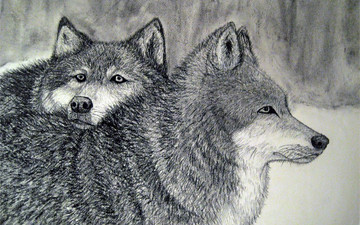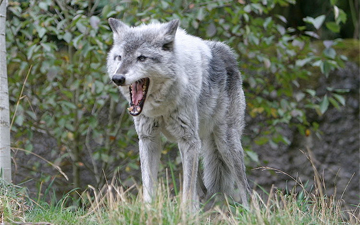The grey wolf (Canis lupus), often known simply as the wolf, is the largest wild member of the Canidae family. Though once abundant over much of Eurasia and North America, the grey wolf inhabits a reduced portion of its former range due to widespread destruction of its territory, human encroachment, and the resulting human-wolf encounters that sparked broad extirpation. Even so, the grey wolf is regarded as being of least concern for extinction by the International Union for Conservation of Nature, when the entire grey wolf population is considered as a whole. Today, wolves are protected in some areas, hunted for sport in others, or may be subject to extermination as perceived threats to livestock and pets.
Grey wolves are social predators that live in nuclear families consisting of a mated pair which monopolises food and breeding rights, followed by their biological offspring and, occasionally, adopted subordinates. They primarily feed on ungulates, which they hunt by wearing them down in short chases. Grey wolves are typically apex predators throughout their range, with only humans and tigers posing significant threats to them.
DNA sequencing and genetic drift studies reaffirm that the grey wolf shares a common ancestry with the domestic dog. A number of other grey wolf subspecies have been identified, though the actual number of subspecies is still open to discussion.
In areas where human cultures and wolves are sympatric, wolves frequently feature in the folklore and mythology of those cultures, both positively and negatively.
(From Wikipedia.org, July 11 2010)
– – –
Gray wolves usually live in packs, led by an “alpha pair.” The pack includes some of the alpha pair’s offspring and may include some unrelated wolves. A pack’s territory can be as large as 13,000 square km. Howling probably helps advertise who “owns” a particular piece of territory. When pups are born, the mother stays near them for the first three weeks, and her mate and others in the pack bring food to her. The pups are weaned when they about nine weeks old. As adults, they may travel as far as 72 km a day with their pack and run as fast as 70 km per hour.
Adaptation: This transparent view of the wolf braincase shows how the brain is situated within. The large feature projecting from the front of the brain is the olfactory lobe, an important center related to the sense of smell.
(From Smithsonian’s North American Mammals via The Encyclopedia of Life, July 11 2010)
– – –





